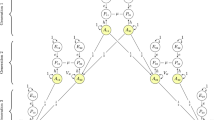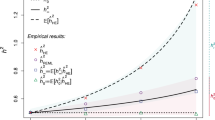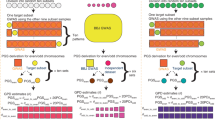Abstract
Assortative mating is clearly important in determining the genetic structure of a population but studies of assortative mating in man have been restricted mainly to the examination of correlations between spouses for single variables. It has been assumed that assortation is based directly on the measured phenotype or on components of the phenotype whose determination is similar in both sexes. Recently, such assumptions have been questioned (see, for example, refs 1–3) because males and females may regard different aspects of the phenotype as important for mate selection. The term ‘asymmetric assortative mating’ has been used to describe such situations. It has also been suggested that the study of the spouses and offspring of twins1,2 may permit resolution of such components of the mating system. Ad hoc models have been proposed (for example, ref. 1) to specify the contribution of asymmetric assortment to the correlations between relatives, but these have not been internally consistent or sufficiently parsimonious. We show here how a simple model based on biological considerations offers a foundation for a consistent and economical theory of asymmetric mate selection which may be used for the analysis of patterns of familial similarity.
This is a preview of subscription content, access via your institution
Access options
Subscribe to this journal
Receive 51 print issues and online access
$199.00 per year
only $3.90 per issue
Buy this article
- Purchase on Springer Link
- Instant access to full article PDF
Prices may be subject to local taxes which are calculated during checkout
Similar content being viewed by others
References
Nance, W. E., In Sing, C. F. & Skolnick, M. in Genetic Analysis of Common Diseases: Applications to Predictive Factors in Coronary Disease, 453–464 (Liss, New York, 1979).
Eaves, L. J. Heredity 43, 399–409 (1979).
Rose, R. J. et al. Nature 283, 375–377 (1980).
Author information
Authors and Affiliations
Rights and permissions
About this article
Cite this article
Eaves, L., Heath, A. Detection of the effects of asymmetric assortative mating. Nature 289, 205–206 (1981). https://doi.org/10.1038/289205a0
Received:
Accepted:
Issue Date:
DOI: https://doi.org/10.1038/289205a0
This article is cited by
-
Genetic evidence of assortative mating in humans
Nature Human Behaviour (2017)
-
Human Mate Selection and Addiction: a Conceptual Critique
Behavior Genetics (2014)
-
On the sources of the height–intelligence correlation: New insights from a bivariate ACE model with assortative mating
Behavior Genetics (2011)
-
The Mediating Effect of Parental Neglect on Adolescent and Young Adult Anti-Sociality: A Longitudinal Study of Twins and Their Parents
Behavior Genetics (2010)
-
Alcohol, Tobacco and Caffeine Use: Spouse Similarity Processes
Behavior Genetics (2006)
Comments
By submitting a comment you agree to abide by our Terms and Community Guidelines. If you find something abusive or that does not comply with our terms or guidelines please flag it as inappropriate.



